#and french toast is jewish CULTURE
Note
Jewish culture is Sunday morning challah French toast :)
.
37 notes
·
View notes
Note
Idk if this will make sense but I love seeing your posts about Bucky making Challah. Making bread is such an excellent like therapeutic hobby to get into generally. It’s a lovely mix of good things. You get something at the end (good for triggering brain chemicals in people who’s brains don’t make them well). It’s a mix of method and flexible because it always follows the same steps of mixing, proofing, shaping, proofing, and baking, but you can make a lot of changes within those steps). That can both fill a need for routine and gives you a creative outlet and lets you move slowly from routine to freedom which is also good for trauma brains. Plus there’s control in making food yourself which is so good and important for so many brain struggles. Plus challah bread specifically also adds in the cultural connection piece. It is just very much living in my head rent free as an excellent headcanon 💙
That makes perfect sense!
Bucky making challah is just such a comfort headcanon for me for all the reasons you stated.
Building on the routine and freedom points:
Many people make a fresh loaf of challah for Shabbat dinner each week. It becomes an important ritual for Bucky, as much as lighting the candles and saying kiddush.
Kneading and braiding the dough is a release from the stresses of that week, something that always grounds him, that connects him to his Ma (who made challah every week when he was growing up) and his Jewish heritage.
Every now and then he'll experiment with different recipes:
Rainbow for pride (of course), garlic and rosemary, cinnamon raisin (which makes amazing French toast), chocolate babka (which also makes amazing French toast), pretzel, tomato basil etc etc...
#Assorted Jewish Writings - Misc#marvel#mcu#bucky#bucky barnes#james bucky barnes#james buchanan barnes#jewish bucky#jewish bucky barnes#jewish!bucky#jewish!bucky barnes
54 notes
·
View notes
Note
6, 15, & 20 📖💗
hi celia ! 📚 thank u for asking <3, answers under the cut :•)
6. what books have you read in the last month?
in may, in reverse chronological order, i read:
why be happy when you could be normal by jeanette winterson
yentl the yeshiva boy by isaac bashevis singer (ok this was out a collection of short stories which i am stilling reading, but it's huge so i don't think i'll finish before i return it. this one really stood out to me and i'd recommend it!)
portraits by kate chopin
eating for england by nigel slater
talk to my back by yomada murasaki
the argonauts by maggie nelson
klara and the sun by kazuo ishiguro
15. recommend and review a book.
i read the kites (les cerfs-volants) by romain gary in april, and i really loved it. i can't remember why i ordered it from the library, i think i must have seen someone on here talk about it. it's set before and during world war 2 in france. about ludo, his postman/kitemaker uncle/guardian, and a polish aristocrat named lila. for a book i basically hadn't heard of before, it was brilliant. i liked the style, the themes of memory, french food, & growing up, ludo's uncle, and getting a feel for a little corner of normandy :•) i imagine it would be even more beautiful in the original french ! 🪁
20. what are things you look for in a book?
i'm often not so interested in plots as much as the quality/richness of the writing, i suppose. i especially like books that paint a picture of a place/culture i am unfamiliar with (portraits for louisiana, the kites for normandy, singer for jewish poland…), and sometimes go through phases where i read books from a particular region and cook some dishes from there too! i am also very much drawn to fiction and memoir with a moderate-to-heavy focus on food !! (kitchen by yoshimoto, joanne harris’s books, toast by slater, crying in h mart....) and i read a lot of cookbooks/food writing, but i don’t really count them 🥘
4 notes
·
View notes
Note
I'm not jewish so I hope I'm not intruding in this space, I love learning about different religions/cultures. I wanted to say I tried challah for the first time the other day and it is DEFINITELY the greatest bread I've ever had. Have a nice day, I hope the hate in your inbox stops soon :(
Don’t worry! Anyone who’s respectful and supportive of Jewish people is welcome here!
Challah is so so good. Fun challah fact: it’s technically not the bread itself but a small piece of bread dough that G-d told the Jewish people to separate from their loaves and give to the kohanim (priests) of the temple. Since there is no longer a temple to give to, the Rabbinical consensus is that the piece of dough be burned as an offering.
There’s a bit of complicated Halakhah about when a dough qualifies to say the blessing and separate the challah, but I won’t get into that here 😊
If you get the chance to try challah French toast it’ll change your life
15 notes
·
View notes
Text
Are We Living Through a Bagel Renaissance?
A New Wave of Shops Has Made Its Mark Across the Country—and Shaken New York’s Bagel Scene Out of Complacency.
— By Hannah Goldfield | April 28, 2024 | Nashville Now

Illustration By Milo Targett
A few weeks ago, after a rare earthquake in New Jersey sent tremors through New York, giving the denizens of the five boroughs a mild shock and an immoderate jolt of self-importance, a writer named John DeVore posted the following on X: “i know nyc isn’t the first city to ever experience an earthquake but imagine how Los Angelenos would react if they, one day, suddenly, ate a delicious, fresh bagel in their city.” It’s an old joke, not least because Los Angeles has lately grown rich in bagels—bagels that some New York transplants insist are actually good, bagels that have earned accolades from even the New York Times, which dared publish, in 2021, an article titled “The Best Bagels Are in California (Sorry, New York).”
I wouldn’t go quite that far, but to write off bagels made outside of New York would be a mistake—not only because there are plenty of great ones to be eaten elsewhere but because New York’s bagel culture, until recently, was growing rather stagnant. I’m hardly the first to note the broad downward spiral of New York bagels, which were first made by Ellis Island-era Jewish immigrants from Eastern Europe and, over the course of the twentieth century, began to assimilate. Once uniformly small, dense, salty, and malty—traditionally, the dough is boiled in water and barley malt syrup before baking—bagels surpassed doughnuts in popularity in the U.S. but also evolved to look more like them, becoming sweeter, paler, and softer. Even in New York, they’ve attained obscene new forms (see: the rainbow bagel), adopted increasingly outlandish flavors, such as French toast (what cinnamon-raisin hath wrought!), and grown ever more puffy as traditional methods of hand-rolling gave way to high-output mechanization. Despite popular claims about the quality of municipal water or baking altitude, the science of bagel-making is not about terroir but, rather, context: every bagel reflects the tastes of the people it exists to serve.
L.A. is just one data point in what Bon Appétit has dubbed “The Great Bagel Boom,” and what Sam Silverman, the founder of New York’s annual BagelFest, calls “a bagel revolution.” Cities across America have long been home to flaccid facsimiles of New York-style bagel shops, but lately they’ve been joined by a new breed: bagel businesses undertaken by ambitious, savvy young people, who are seeking not to replicate some Platonic ideal of the bagel so much as to make it their own. Every city—see Miami’s El Bagel, where the menu includes a bagel layered with guava marmalade, cream cheese, and a fried egg, and New Orleans’s Flour Moon Bagels, which offers bagel “tartines” (plus, sometimes, a crawfish-stuffed bialy)—seems to have its own new-wave status bagel, which draws fanfare on social media and long lines in real life. “The bagel business has been, historically, a pretty terrible business, but the rise of this sandwich culture really helps,” Silverman told me. “It’s a vehicle that can infuse any sort of local culture and cuisine.”
The last time I was in L.A., I made a trip to the most famous of the city’s entries to the field. In 2020, the owners of Courage Bagels, who initially peddled their wares from the basket of a bicycle, opened a brick-and-mortar store in Virgil Village, between East Hollywood and Silver Lake. Midmorning on a Monday, I joined a line that had at first seemed reasonable and quickly became a way to spend half a day, snaking down the quiet block, opposite a dollar store and a tattoo parlor. When I started a casual conversation with the woman in front of me, she seemed almost startled. She had moved recently from New York, it turned out, to work as an assistant to an entrepreneur, whose bagel she was waiting to order. “People don’t make small talk in L.A.!” she said. Another former New Yorker in front of her, overhearing us, nodded in weary agreement.
It was easy to see how a Courage bagel could offend, if not enrage, a New York purist. It brings to mind a rustic, crusty baguette: the exterior is dark, craggy, and heavily blistered; the crumb is a little stretchy with a lot of air holes. (Courage bagels are leavened with sourdough starter, rather than commercial yeast.) If you were to scoop it, another move for which a bagel aficionado might make a citizen’s arrest—stay safe out there!—you’d be left with mostly crust. This makes it especially suited to Courage’s main offering: photogenic open-faced sandwiches. Bagel halves are topped with various combinations of cream cheese, jewel-like slices of tomato, thin coins of cucumber, smoked salmon, roe, or sardines, then painstakingly finished with salt, freshly cracked pepper, a drizzle of olive oil, fronds of dill. A Courage bagel is a Los Angeles bagel, ready for its closeup.
You could argue that the nationwide bagel revival has been a boon to New York’s own scene, shaking it out of complacency. Ten years ago, the introduction of Black Seed’s Montreal-inspired bagels, which are thinner and sweeter, boiled in honeyed water, only improved the landscape. Lately, the city has been home to a growing roster of indie bagel-makers, many of whom started by churning them out of restaurant kitchens during off-hours, or at home. On a recent Saturday morning, as I picked up a half-dozen sourdough bagels and a tub of burnt-scallion cream cheese from Wheated Brooklyn, a pizza restaurant just south of Prospect Park, the owner, David Sheridan, told me, “There’s a bagel movement happening in this country.” Louisville, Kentucky, of all places, had inspired him to get into bagels: as he prepared to open a location of Wheated there, he noticed a huge hole in the bagel market. Back in Brooklyn, he dove into R. & D., selling the fruits of his experiments on the weekends.
Earlier this spring, the people behind Leo, a sourdough-pizza place in Williamsburg, opened Apollo Bagels, in the East Village, which serves L.A.-inflected bagels, open-faced and meticulously assembled. (If I were the owners of Courage, I’d cock an eye at Apollo and remind myself that imitation is the sincerest form of flattery.) The Mud Club, a wood-fired bagel, pizza, and tapas restaurant and dance club in the Hudson Valley, is currently popping up on the Lower East Side in the original location of Scarr’s Pizza, where, the other day, I ordered a bacon, egg, and cheese, oozing aioli and roasted-jalapeño-and-tomato jam, on a dense and crusty everything bagel. (They’ll soon open a permanent outpost a few blocks away.) Sakura Smith, the baker behind Bagel Bunny, supplies private clients and sometimes specialty shops with small, soft bagels made from a vegetable-flecked dough; it’s leavened with a fermented yeast that she says was first grown by a monk in Japan in the nineteen-seventies and feeds off mountain yams, rice, and carrots.
When it comes to my own bagel preferences, I am open to creative recipes but believe that a bagel should be, fundamentally, a humble staple—relatively inexpensive and sold by the dozen, or a multiple thereof. A sandwich has its place, but bagels belong, first and foremost, in a paper sack, hot from the oven (they need not be toasted unless they’ve gone stale), grab-and-go. The new-wave shops, especially outside of New York, don’t all seem to embrace the bagel’s inherent utility. In Washington, D.C., at a café called Ellē, my six sourdough bagels came packaged in individual paper sleeves, as if they were croissants or artisanal chocolate-chip cookies. At Courage, I had to wait—and wait, and wait—for my half-dozen. As the sun grew hotter, and I paced back and forth, restlessly sipping on a rose-flavored lemonade, I had to wonder, What were they doing in there? You could imagine a chef adhering sesame seeds one at a time with a tweezer.
The newcomer bagel that best fits my vision can be found in New York but it was born—sorry, haters—in Westport, Connecticut. One day in the summer of 2020, Adam Goldberg, a flood-mitigation specialist in his forties, was floating in his pool with his cousin, “having margaritas at eight-thirty in the morning,” he recalled recently. “We looked at each other and we decided that it was too hot to make sourdough like we’d been making every other day for the whole pandemic.” They decided to make bagels instead, imagining that they’d be “more refreshing.” After just a couple of weeks of recipe-developing, Goldberg settled on his ideal formula, and it wasn’t long before he was selling bagels out of his back yard. Four years later, the business, PopUp Bagels, is growing rapidly, with multiple locations in Connecticut and in tony precincts including Greenwich Village, Palm Beach, and Wellesley, Massachusetts.
PopUp offers, strictly, bagels and schmear, and if you preorder a dozen to pick up from the store, they will still be warm when the paper bag is passed to you. Goldberg is careful not to describe PopUp bagels as New York bagels. “It was the first thing we dropped from our branding,” he told me. “We’re our own style of bagel.” He uses a proprietary mix of flours and commercial yeast, no sourdough, and he has worked under the guidance of a “dough coach,” a championship baker he’s hired “to refine our recipe so that it’s more mobile.” When I asked him if he’d been aware, before getting into bagels, that there were people who called themselves dough coaches, he said, “No. In fact, my dough coach was unaware of it also. But once I told him he was my dough coach, he was very excited.”
A PopUp bagel is a bit less dense than the most traditional New York bagels; Goldberg wanted to make them light enough that you could comfortably eat more than one. In other ways, a PopUp bagel seems archetypal: small, chewy, with a crisp, golden-brown crust—urbane, and almost chic, in its restraint. Goldberg has kept the flavors classic, offering just plain, sesame, poppy, everything, and salt. He only gets playful with gimmicky (and sometimes great) cream-cheese flavors—Old Bay, ramp, coffee cake—and the occasional absurdist collaboration; just last week, PopUp and Dominique Ansel, of Cronut fame, introduced a limited-time-only Gruyère bagel with escargot butter, for a cool eighteen dollars.
This may seem like an awful lot of fuss over boiled bread with a hole in it, but pedantry is part of the fun. We enjoy outraging the purists and then posturing as purists ourselves, bringing our own tastes and associations to the image of the perfect bagel. I discussed this recently with Zoë Kanan, a pastry chef and baker who can make an excellent bagel anywhere (she once did a stint as a bagel consultant in Mexico City) and who will open a Jewish-ish bakery, called Elbow Bread, on the Lower East Side in May. Kanan and I were both introduced to bagels inauspiciously. Every day in elementary school, in New Haven, I ate a sandwich of Genoa salami on a squishy egg-flavored Lender’s bagel—the brand sold in plastic sleeves in the grocery store. Kanan grew up in Houston, where her weekly order at the Hot Bagel Shop was a strawberry bagel with strawberry cream cheese. Which is to say that, when it comes to bagels, we were blasphemers: in the High Court of Bagel, we’d be sternly sentenced to a penal colony.
Despite these beginnings, or perhaps because of them, Kanan and I now share a strong internal compass about what a bagel should be. “Chew is at the top of the list,” she said, as I nodded fervently at the other end of the line. “It should, I think, give your jaw a little bit of a workout when you’re eating it.” She explained that a low-hydration dough (as opposed to, say, the wetter dough you need for a spongy focaccia) made with high-protein flour gives you a strong gluten structure, and optimal chewiness, but can also result in a bagel that stales quickly. To extend shelf life, she’s come up with a slightly left-field solution: potatoes, roasted whole, skin-on, and mixed in with the flour, yeast, and water. “It adds starch, which locks in moisture,” she explained, and also results in “a really thin, kind of crackery shell of a crust. And then, the interior is chewy, and also tender, and moist.” I pictured an arrow hitting a bull’s-eye.
One New York bagel shop that sates both traditionalist tastes and the Internet’s appetite for absurd viral foods is Utopia, in Whitestone, Queens. Here, they hand-roll the bagels, boil them in enormous kettles, and then bake them in a carrousel oven made in 1947. They’ve got all the essential flavors, including pumpernickel—a favorite of mine, and rarer and rarer these days—but if you want sourdough they have those, too, plus rainbow, piña colada, and jalapeño-cheddar. As if to provoke the snobs who complain about ballooning bagel sizes, they also sell a ten-pound “party style bagel wheel,” an audacious rejoinder to the party sub. The giant everything bagel I ordered the other day was, I’m sad to say, completely raw in the center. (My theory was that they’d taken it out too soon, when the garlic that dotted the exterior had started to burn.) But I’d also ordered a party-style pizza bagel, a sesame ten-pounder sliced in half, scooped (the extra dough gets turned into garlic knots), and layered with marinara sauce, mozzarella, and chopped chicken cutlet. It was outrageous yet comfortingly familiar and, dare I say, spectacular. ♦
— By Vaseline
0 notes
Text
Exploring the Wonderful World of Bread.
Introduction:
Bread, a timeless staple in cultures across the globe, comes in an array of forms, flavors, and textures. From crusty artisan loaves to soft, pillowy rolls, the world of bread is diverse and fascinating. In this blog post, we'll embark on a delightful journey through the types of bread that grace our tables and tantalize our taste buds.
Artisan Bread: *Characterized by its rustic appearance and hearty texture, artisan bread is a testament to the craftsmanship of bakers. Made with minimal ingredients – typically flour, water, salt, and yeast – artisan bread undergoes a slow fermentation process, resulting in a chewy interior and a crusty exterior. Popular varieties include baguettes, ciabatta, and sourdough.
Whole Grain Bread: *For those seeking a healthier option, whole grain bread is a nutritious choice. Made from flour that includes the entire grain, this bread is rich in fiber, vitamins, and minerals. Varieties range from whole wheat to multigrain, offering a robust flavor profile and a hearty texture.
Brioche: *Indulgent and buttery, brioche is a French bread known for its rich, slightly sweet taste. Made with a generous amount of eggs and butter, brioche has a soft, tender crumb that makes it perfect for both sweet and savory applications. Enjoy it as toast for breakfast or as the base for a decadent sandwich.
Flatbreads: *Found in various cultures worldwide, flatbreads are a versatile category that includes staples like naan, pita, and tortillas. These breads are often unleavened and can be used to scoop up dips, wrap around fillings, or accompany a variety of dishes. Each culture puts its unique spin on the flatbread, resulting in a diverse range of flavors and textures.
Bagels: *Hailing from Jewish tradition, bagels are boiled before baking, giving them a chewy interior and a shiny, slightly crispy crust. Typically enjoyed with cream cheese or used as the base for sandwiches, bagels come in an array of flavors, including plain, sesame, poppy seed, and everything.
Rye Bread: *Known for its distinctive flavor and dense texture, rye bread is often made with a combination of rye and wheat flours. Popular in European cuisines, it can range from light and mild to dark and robust. Rye bread pairs exceptionally well with cured meats, cheeses, and pickles.
Conclusion: The world of bread is a testament to the diversity and creativity of culinary traditions. From the artisanal craftsmanship of sourdough to the comforting warmth of naan, each type of bread brings its unique personality to the table. So, the next time you break bread, take a moment to savor the rich tapestry of flavors, textures, and cultures that this humble staple represents. After all, there's a type of bread for every palate and every occasion.
1 note
·
View note
Text
Culinary Delights Unveiled: Exploring the Best Restaurants in Los Angeles
Introduction
Los Angeles, a city known for its vibrant culture and diverse population, is also a culinary paradise that boasts some of the best restaurants in Los Angeles. From international cuisine to local favorites, the city offers a plethora of dining experiences that cater to every palate. In this article, we embark on a gastronomic journey through the heart of Los Angeles, exploring the finest dining establishments that grace the city's culinary landscape.
The Best Restaurants in Los Angeles
Providence:

Cuisine: Seafood
Highlights: Impeccable seafood dishes, elegant ambiance, and a Michelin-starred experience.
n/naka:
Cuisine: Japanese
Highlights: A unique kaiseki dining experience, known for its artistry and flavor.
République:
Cuisine: French
Highlights: A beloved bakery and restaurant, known for its artisanal bread and delectable French fare.
Guelaguetza:
Cuisine: Oaxacan
Highlights: Authentic Oaxacan cuisine, famous for its mole dishes and welcoming atmosphere.
Bestia:
Cuisine: Italian
Highlights: Renowned for its house-made charcuterie, pizza, and pasta, often with a modern twist.
Sqirl:
Cuisine: Breakfast and Californian
Highlights: Innovative breakfast and brunch options, famous for its ricotta toast and homemade jams.
The Little Door:
Cuisine: French and Mediterranean
Highlights: A romantic courtyard setting, known for its Mediterranean-inspired dishes.
Langer's Deli:
Cuisine: Deli
Highlights: A classic Jewish deli famous for its pastrami sandwiches and rye bread.
Ink:
Cuisine: Modern American
Highlights: An inventive and creative menu, known for its unique flavor combinations.
Guerrilla Tacos:
Cuisine: Tacos
Highlights: Gourmet tacos served from a food truck, offering a modern twist on traditional street food.
The Los Angeles Culinary Experience
Exploring the best restaurants in Los Angeles is not just about satisfying your appetite; it's about immersing yourself in a vibrant culinary culture that reflects the city's diversity and innovation. Whether you're savoring a Michelin-starred seafood dish at Providence or indulging in the flavors of Oaxaca at Guelaguetza, Los Angeles offers a culinary journey like no other.
These restaurants not only serve exceptional food but also provide unique dining experiences, from elegant fine dining to food trucks serving gourmet tacos. Los Angeles' culinary landscape is a testament to the city's rich tapestry of cultures, where traditional and modern flavors blend harmoniously.
So, whether you're a local looking for your next food adventure or a visitor eager to explore the city's culinary treasures, Los Angeles offers an abundance of delectable options that will leave you craving for more.
0 notes
Text
Miami Kosher - A Guide To The Best Kosher Restaurants in Miami
When it comes to food, there's nothing like variety! That's why you'll find a wide range of kosher restaurants across Miami - from budget-friendly options to high-end establishments. And even if you're not specifically looking for kosher food, chances are you'll love at least one of the restaurants on this list. From mouth-watering salads and fabulous pizzas to decadent pastries and sumptuous breakfasts, there is something for everyone on this list. So whether you're new to kosher food or just want to explore some new options, be sure to check out Miami Kosher!
What is kosher food?
Kosher food is a delicious and nutritious way to enjoy your food. It's defined as foods that have been prepared in accordance with Jewish law, which includes certain restrictions on the types of meat and dairy products that can be eaten. Miami is home to a large Jewish community, which means there are many great kosher restaurants in the city. If you're looking for an extra special meal, head to a kosher restaurant in Miami! Not only will you be dining on some of the best kosher food around, but you'll also be supporting a local business.

Types of kosher food
There are a few different types of kosher food to choose from in Miami:
Pizzas: Whether you're into simple cheese or pepperoni pizzas, there's a great pizza restaurant for you on this list. And don't forget the vegan and gluten-free options!
Salads: A great way to start your meal is with a salad - whether it's creamy chicken or tuna salads, they're all delicious. You can also find healthy versions of classic salads like Caesar and Greek salads.
Baked goods: From croissants to pains au chocolat, bakeries like these are a must-try if you're a fan of sweet treats. And don't forget the Dutch apple pie - it's every bit as good as advertised!
Breakfast: Whether you're looking for eggs benedict or French toast, there's something delicious to love on this list. In addition to great food, many of these restaurants also have amazing views. So consider grabbing breakfast at one of these places before heading out into Miami's sunny weather!
Why is kosher food important?
Kosher food is an important part of Jewish culture and history. It's also a great way to maintain healthy dietary habits. Many kosher restaurants in Miami offer dishes that are not readily available at non-kosher establishments. The best kosher restaurants in Miami offer delicious, high-quality food that is perfect for special occasions or everyday meals! So whether you're looking for a delicious kosher meal or just some guidance on where to find the best kosher restaurants in Miami, make sure to check out this blog post!
Food standards for kosher restaurants in Miami
When it comes to food, Miami is all about diversity and authenticity. That's why the city is home to some of the best kosher restaurants in the country. As a kosher restaurant in Miami, all food must meet stringent food standards set by the Orthodox Union. This includes things like using strictly kosher ingredients, being prepared in a kosher manner, and adhering to dietary restrictions. If you're looking for a delicious and authentic kosher meal, be sure to research which restaurants are best suited for your needs. Make sure to ask about specific dietary restrictions in advance, so you don't have any surprises on your plate. And last but not least, enjoy a delicious meal at one of Miami's top-rated kosher restaurants!
The best Kosher restaurants in Miami
Miami is a city rich in Jewish culture, and that doesn't go unnoticed in the culinary world. As a result, there are many kosher restaurants in town - perfect for anyone looking for delicious and nutritious meals. Make sure to ask about any dietary restrictions when making your reservations, as many restaurants have adaptations made for kashrut. Although Kosher food is usually more expensive than traditional food, it's worth the expense for the quality of the meal. And don't forget to enjoy a delicious dessert after your meal - Miami's Kosher restaurants have something for everyone.
The Best Kosher Restaurants in Miami for special occasions
If you're looking for a great kosher restaurant in Miami for a special occasion, you're in luck! From Passover celebrations to Shabbat dinners, Miami has a variety of restaurants that offer a delicious and authentic Jewish experience. Be sure to check out Chabad of South Beach and Joe's Stone Crab Grocery & Barbeque Lounge, two popular choices that are sure to satisfy your taste buds. Make reservations early, as they tend to book up quickly. And don't forget to take advantage of the delicious kosher dishes that these restaurants have to offer!
Why is kosher food so popular in Miami?
Kosher food is famously delicious and popular in Miami. There are many kosher restaurants in the city, so finding one that fits your dietary restrictions is easy. The food at kosher restaurants is renowned for its flavors and quality. Combine a trip to Miami with some delicious kosher dishes at one of the local eateries for a fantastic dining experience. Kosher food is especially popular in Miami because it's a melting pot of cultures and religions. So, whether you're looking for a great place to eat with friends or family, Miami Kosher is the perfect guide for you!
How should I order kosher food in Miami?
When it comes to kosher food, Miami has it all. From acclaimed restaurants that specialize in kashrut d'var Torah (the strictest level of kosher food), to vegan and gluten-free options, there's something for everyone. Make sure to order kosher food in Miami the right way by knowing the different types of meat that are used, and how to order dairy products. Many restaurants in Miami also offer both vegan and gluten-free menus, so there's no need to be limited!
Where can I find kosher restaurants in Miami?
If you're looking for a delicious and healthy kosher meal, Miami is the perfect place! Not only is the city home to a growing Jewish population, but there are also many kosher restaurants in Miami. Use the search function on this website to find restaurants near you, and be sure to read the reviews before making your reservation. Additionally, be sure to enjoy some delicious food while enjoying a fulfilling and healthy meal. Kosher Miami has everything you need to explore the city's many kosher restaurants!
Conclusion
If you're looking for the best kosher restaurants in Miami, look no further! In this blog, we've outlined everything you need to know about kosher food and the importance of eating it. From food standards to ordering tips, we've covered everything you need to make an informed decision about where to eat in Miami. So what are you waiting for? Head on over to our website and start enjoying the best kosher food Miami has to offer!
Ms. Dixie
Address: 21000 West Dixie Highway Miami, Florida 33180, United States
Phone: (305) 933-3305
Website: https://msdixiemiami.com/
#kosher food#best restaurants#mediterraneanfood#restaurant near me#Kosher food in Miami#Hamburgers in Miami#Kosher restaurant near me#Vegan burger in Miami
0 notes
Note
hi my love i’m hope not too late but i would like you to tell me about my loves jewish cake, anything you want to but specifically baker calum 🥰 thank you i love you
of course you aren’t too late!!! ESPECIALLY to talk about jewish cake oh my goodness meg i shall die for you i love you. alright let’s see what i can dig up
ha’ahava hazot shelanu + it’s so simple
a cut, per usual
so let’s start WITH:
ha’ahava hazot shelanu
jewish cake was a labor of love for myself. little known fact about me is that i am in fact jewish! :) and around christmas time i always get a little prickly about the surplus of christmas spirit and in this case the amount of fic for it. and i’d sort of had this hesitant idea to write a jewish fic in the back of my mind for a long time, but it felt like a really big divergence from the Cast of Characters that was for some reason a lot more dramatic than any other circumstances into which i could place them, so i’d basically been hesitating for several months. in november we had a brief conversation about it in the club which looked like this

but the idea still made me a little nervous and so i kind of talked myself out of writing it, as always. and THEN, middle of december, iba sent me this 1d fic out of nowhere with this accompanying message:

and i kinda lowkey almost cried!! it was such a jewish fic. i read the word kvetch and i almost lost it. the fic was just so unabashedly jewish. and i was like...well. that’s what ive been wanting to do. so now i have no reason not to do it.
in the ao3 notes i talked a little bit about my internal debate over How Jewish To Go with the fic because on the one hand i really do understand that it can feel alienating going into a fic with zero understanding of the culture but on the other hand since it was MY fic i wanted to make it jewish the way i’m jewish. which is like...............very. i don’t think i ended up striking a balance so much as just deciding to say fuck it and write it the way i would want to read it, but i definitely think that was the right decision for me.
there was actually one more motivator for writing this fic, especially the WAY i wrote it, in eight chapters, and that motivator was that i wanted to break 400k on ao3 before the year ended. i just wanted to have an even number and 400k was a good goal. which i did achieve thanks to jewish cake fic being the 13.6k beast that she is! so that was also part of it
NOW! as for the PROCESS. i created the doc on december 22 and i originally kind of thought it was a little bitchy to write a hanukkah fic after hanukkah had already ended but was reminded that most christmas fic is neither written nor posted on actual christmas which reassured me well enough. i had already had the idea to divide it into eight chapters for the eight nights of hanukkah and i thought that would be a nice way to showcase different aspects of the holiday (seeing family, playing dreidel, opening presents etc) and also in certain cases (like the third chapter where they do some baking) some days that weren’t necessarily hanukkah-driven but just a nice natural consequence of being on break for hanukkah. i wanted it to feel like hanukkah feels to me!! normally i don’t like people seeing the way my outlines look but this one i don’t mind sharing so here’s what i had at the top of the doc for reference while i was writing. not everything in that first list got included but most of it did !!!

i’m not really sure how this fic ended up being cake. i never used to default to cake but for some reason as i was diving into this one it just felt right. that’s all i can say about that. meg you have genuinely shifted my approach to fic i DO default to cake sometimes now and that’s on YOU.
the very first thing i ever wrote down for this fic was this part that ended up going in the summary:
“Happy Hanukkah,” Calum says, smiling at Luke as their fingers intertwine.
Luke murmurs, “Chag sameach, ahovi,” and Calum’s face is aglow in the candlelight.
that was The Moment for me. i didn’t even write the rest of that scene until later but i had those two lines written down straight out the gate and i knew they were gonna close out the first scene because it just Felt Right. and i was right! very cool and fun for me
now the nice convenient thing about having this fic separated into eight discrete scenes/nights/chapters was that i didn’t have to write it in order, and i didn’t. i DID write the first night/chapter first, but then over the course of maybe a week, i wrote (deep breath get ready): the first half of chapter 2 (hemmings family) > the beginning of chapter 5 (the dreidel game) > most of the scene in chapter 7 > the beginning of chapter 3 (where they bake) > finished writing chapters 2 & 3 > started chapter 4 and finished chapter 5 > finished chapter 4 and wrote the rest of chapter 7 > all of chapter 6 > all of chapter 8 aka the proposal. i deliberately saved the proposal for last because i don’t think i could have written it exactly right without knowing the events that came before it but everything else was all over the place as you can see.
a problem i ran into a lot, and i talked to my sounding board and fellow jew sam about this among many other things, was that i had a lot of trouble characterizing very obviously Not Jewish people in a way that made them Very Jewish. not even like, Jewish But You Can Ignore It. i wanted them to be front-and-center jewish like i am and that was hard for me to navigate because obviously my speech patterns and vocabulary as an american jew are extremely different from 5sos’s as australian goyim (non-jews) like i do use hebrew words in my day-to-day communication all the time and i somehow had to keep their mannerisms but also insert mine BUT not insert so many of mine that the fic became incomprehensible and it was just. a Challenge. here’s some insight into THAT crisis


and then again writing the other characters in other chapters

i sent sam the doc when i was mostly done writing it, mainly just to be reminded that at least one person was going to appreciate this fic, which worked out nicely because she very very much did. genuinely i cannot stress enough how insecure i was to write and share this fic. like i’m gonna be really straight up with you meg, i think part of the reason i had calum and luke baking sufganiyot was because to me that felt like a sort of bribe? i basically wrote what felt to me like the least appealing fic ever and then my mission from there was to add stuff in that would convince people to give it a shot anyway. i was trying to make it worth everyone’s while. the baking was my trade-off, i was like “well yeah it’s a jewish fic but maybe she’ll be happy enough that it’s cake and they’re baking that she’ll forgive it for being a jewish fic” yes i realize how kind of hilariously tragic this sounds but !!! you never get jewish fics!!! and you especially don’t get them in fanfiction for obviously non-jewish bands!!! anyway. we’re not gonna get into this whole thing but like. even though objectively i knew that i had been told again and again people would appreciate the fic i still had doubts and knowing something and feeling secure in it are very different things.
also, i didn’t remember this, but apparently i had a lot of problems with writing the proposal! here’s a sneak peek into that mental breakdown


don’t actually think the fic specifies (making life easier for myself) but they have already had dinner in that scene. so now you know.
i could choose to not get this elbows-deep in the details of Crises I Had While Writing This Fic but instead i am choosing to go all out. here’s another thing i had trouble with:
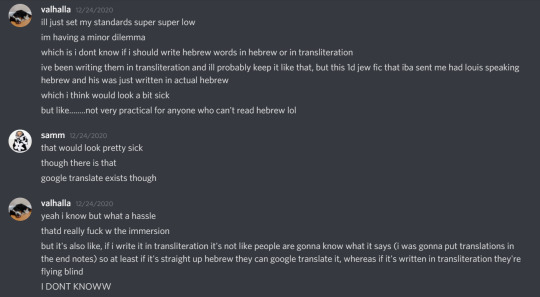
(i did end up using transliteration obviously but i DO think actual hebrew would have been a cool flex)
and as for the title, ha’ahava hazot shelanu is the name of an ivri lider song that i love, and it translates to “this love of ours” and i realize titling the fic in hebrew was a Choice but i did talk to sam about this as well and that went roughly like this

by the way here is the song, i absolutely love it and i cannot recommend it enough. also i’m not sure how glaringly obvious this is but the chapter titles on ao3 are just hebrew numbers. like the first chapter is echad which literally means one. and so on. are they the correct genders? i don’t know ! fuck gendered language.
one more thing and then ill move on but an unfortunate natural consequence of writing a hanukkah fic (at least the way i wrote this one) is that it necessitates presents. so i had to come up with presents for these dumb boys to give each other. and to be completely honest with you i don’t remember how i did!!! the ones calum got for luke were trickier because they were actual things. for some reason this luke was always a version of luke that just kinda like, wore makeup, so that was just a question of figuring out an eyeshadow palette that would be Nice but not obscenely schmancy (i did ask the club for help since i know nothing about makeup but as usual i ignored their replies). but that by itself didn’t feel like enough of a gift, and so i tried to think of something that would be more than just the gift of an object. like, something that would maybe enable luke to spend more time on something he loves. piano music made sense to me because it wasn’t just a thing by itself it was a thing that encouraged luke to play piano and even to improve at it and to learn songs that he could be excited about. so! that was that
the trip to israel gift was a little bit of a retcon situation i really liked the idea that luke had been planning to give that “gift” to calum for a hot sec that he’d have had it ready, but i’d already written the scene where he and mali talk about israel, so i went back to it and edited it a little to hint at the idea (luke plays it off very casually because he is a clever boy) but i thought there was something very romantic in the idea of the israel trip, of luke planning a future with calum and a trip to a place that means so much to him (to me yes maybe luke and i are the same blah blah) and getting to drag calum around to falafel places and teach him words in hebrew and it just seemed like the appropriate trip for these two cute jewish boys to plan so i rolled with it.
okay moving on slightly!! to baker calum <3 baker calum was more of a cameo in the hanukkah fic, in the chapter i wrote with you in mind, but i can talk about it’s so simple here as well because i fucking adore that fic.
it’s so simple
so the inspiration behind the fic came from the “kitchens are for lovers” rhetoric and the realization that that would be the perfect...sort of thesis to build on for a fic for you in specific, because you are, in my mind, a very kitchen-based person, given your baking habit. it actually just worked out pretty nicely for me honestly because i’ve been wanting to write a big Kitchen Romance type fic for a while and you just gave me the perfect opportunity. here’s what i had at the top of the doc for the fic for you

and then once i sort of landed on the idea for the fic, it just made a lot of sense to make it jewish cake because, well, im gonna be real w you, because i identify very strongly with jewish cake and the kitchen-romance aspect felt like a very bella thing in the same way that jewish cake felt like a bella thing. and so i wanted to be able to romanticize these kitchens to share the way that i, bella, feel about them, and that was easy to do when the characters were so similar to me. not to mention this cake already existed in my head as a very settled, domestic duo, and they had their own home and had already had a kitchen-romance scene in the hanukkah fic and the whole thing just fell together perfectly. i had this sentence in my head and it was: “Shabbat in Luke and Calum’s kitchen looks something like this.” the kind of thing you would read in a fic summary right? and especially having it take place on shabbat felt like an extra layer of domestic easy romance to me so that was kind of my guide
here was my "outline” for this:

Romance :)))
obviously calum was going to be the one doing most of the cooking/baking because he had been established as the Kitchen Boy between the two of them and maybe i realized in the course of writing it that while i was luke, you were very much calum. so the goal was then basically to romanticize (1) the kitchen and (2) luke as much as humanly possible for you (see: message sent to helen and ainslee)

unfortunately i was unable to do baker calum justice as much as i would have liked because i could not have him baking anything complex because i can’t bake anything complex and if i had tried to describe him baking something complex and then described it wrong i would have died of shame so that is why he is only baking brownies BUT they have chocolate chips which hopefully makes up for it. also i just stumbled across this which i think pretty well represents the crisis i had regarding baker calum

:)))
re: the soundtrack (so to speak), i wanted to include some songs that i associate with you meg but you see the situation is that some of those songs are 5sos/mali/atl songs and so i couldn’t include those, for obvious reasons, which did narrow down my choices somewhat. fortunately i think the mcfly worked pretty nicely i mean yeah it’s a little obvious that i was forcing mcfly into the story but they deserved to be there. i think i’ve mentioned this but i genuinely have a memory of listening to star girl on a loop in my kitchen at home and in my head the hood-hemmings kitchen looks like my kitchen because i have zero imagination so it felt to me like these songs just belonged in kitchens. and that they’d be inherently romantic. woah i think my brain is short-circuiting i’m not sure i’m making sense anymore. point being i hoped that you would appreciate it nonetheless.
a note about the short introduction, because it’s very unlike anything i’ve put in any other fic to my knowledge. i kind of wanted it to feel like the prologue to a fairytale, almost. i wanted it to feel like the beginning of a movie, when the camera is slowly, slowly zooming in from a Big Picture down to one house on one street and then through the window into the kitchen while the voiceover is very serenely describing the scene. i wanted it to feel like we were in the kitchen before even calum was and that we were standing against the fourth wall watching the fic unfold. and also, i wanted to make the fic romantic as fuck, from the get-go. there was to be no confusion: this fic was going to romanticize the living daylights out of the hood-hemmings kitchen.
(also you may have noticed that despite having “london” in the list of Meg Things at the top of the doc, the fic never actually specifies that they’re in london. that’s because this fic was really an exercise in “how much can i hint that they’re in london without outright saying it so i don’t establish a canon that i may later regret” which went as far as me asking helen what her kitchen floors and counters are made of. like. if you want it to be in london then hell yeah it’s in london but i didn’t wanna lock myself into that decision just in case so i never actually said it but i hope it kinda felt london-y anyway lmao)
so...............i THINK that’s all i have to say. “all” as if i havent just written an entire dissertation but at least it’s done now. i sure did say a lot! that was a lot!!! but also a very very fun and interesting dive into the ~process~ of writing these jewish cake fics. also, for what it’s worth, the way hanukkah fic was received basically calmed all my fears about writing jewish fic, which was a relief for me. so thank you for loving it, i don’t think you know how much that means to me!!!! i love YOU so very much
#kaleidoscopeminds#ask#answered#christ go off i guess????????#i honestly have Nothing to say in the tags because i said so fucking much in this answer#fgldkhgsdflj#here are some other questions i asked helen the resident london expert:#'you guys don't have saturday morning cartoons do you'#'what do you call french toast' to which i was informed that you (brits) don't HAVE french toast#and then i decided to ignore that information and include it anyway because jewish tradition trumps british absence of food#and french toast is jewish CULTURE#'do you guys say suck-up or is there a different thing you say'#i did NOT like the answer to that one#also 'do you guys have dishwashers'#'do you guys do april fools'#helen litearlly went and took a photograph of her counters so that i could see what they looked like. THATS love baby#the fact that i said i had nothign to say and then i continued to say things anyway#thats pretty on brand for me#meg#director's cut#okay im posting this now. FOR REAL#dunno what happened before that was very unsexy but this time for real
4 notes
·
View notes
Note
The Bird Boys and cooking? Steven seems like he makes really good Challah bread French toast but Jake could probably make good matzoh ball soup without the matzoh balls getting dense as rocks
I will preface this with the fact that I am not very familiar with Jewish food. So here are my thoughts on their cooking more generally.
Moon Knight and cooking thoughts

Marc Spector
Between the admittedly okay food at Putnam Psychiatric and the MREs of the marines, I doubt Marc had many cooking skills prior to his time as a mercenary. However, between having a French best friend and the overall flavorful food of the Middle East and his other travels, I think he developed a more eclectic palette. I think he’s learned a lot about more uncommon (in the US) seasonings and definitely learned some French recipes as well. Overall, decent cook who definitely has a spice for every occasion, 8/10.
Steven Grant
I agree that Steven is big on baking, especially more savory baking such a bread. I do think he’d particularly enjoy French toast, he loves sweet things, especially cinnamon. I will say that he, particularly, enjoys teaching his s/o how to bake a treat or learning from them. He sees baking for someone or with someone as the epitome of romance. I imagine if you’re part of a different culture, he’s particularly enthusiastic. He loves learning more about you. A sweet and sensual baker who’s open to new things, 9/10.
Jake Lockley
Honestly, what can’t this man do? He’s the master of more homey foods. Soup? He’s got you. Breakfast in bed? He’s also got you. He also has a way of working your coffee machine such that’s it’s able to produce perfectly brewed lattes and other more fancy coffees. He spent so much time helping Gena that he’s practically got her flapjack recipe memorized. Loving husband and savory cook + breakfast in bed and coffee, 11/10.
Mr. Knight
He can cook food technically. Okay I’m being dramatic, it isn’t bad. He’s much more keen to take you on dates to fancy restaurants or getting take out. He has a lot of skills, cooking isn’t one of them. However, if you cooked for him, he’d literally melt. He can manage a tomato soup or particularly good grilled cheese though. Trying his best really, and lucky for him, his best is pretty good, 7/10.
24 notes
·
View notes
Text
The Prince of Egypt
Today I’ve decided to discuss the Dreamworks & Universal animated film The Prince of Egypt. As someone who is roughly 50% Jewish (dad is 100% mom is not at all as far as we know) I was surprised when my non-jewish best friend was insisting I watch this movie. I was a little nervous because I felt that it was one of those movies that could be ruined so easily.
Instead I was happily surprised, the animation even in 1998 being STUNNING (if you haven’t seen the parting of the Red Sea scene I’m gonna link it below because let’s face it, it’s gorgeous). When I first watched it I loved it purely from the animation, the way the story was told, and the music being amazing. Over this past weekend though, I was curious and looked up the main character’s cast, and everyone is of Jewish descent, and I discovered that Hans Zimmer, while writing When You Believe, actually spoke with Rabbi about lyrics.
I was shocked that so much thought had gone into this beautiful film, and as of right now this movie has climbed its way into my number one favorite movie position, watching it up to three times in a day sometimes, and certainly listening to the soundtrack at least ten times a day.
I’m surprised I enjoyed it even just because of the story, because I’m not huge on judaism as a religion. I’m much more into paganism, but that’s a whole other story. I’ve been raised within my dad’s heavily jewish culture, making latkes, ripping apart Challah bread for french toast, lighting the menorah and saying the prayers. Even now, I try to eat kosher on my own. But I’ve never ever felt a connection to the religion, simply the culture and the racial part that is within my blood and skin. Nonetheless, this movie struck a something within me, and it gives me chills and makes me cry every time.
I highly recommend this film to anyone of any race, religion, culture, any of it. It’s hard not to enjoy a film like this.
youtube
38 notes
·
View notes
Note
What do you think Napoleon would feel about the Le Pens? Like I know he’d hate their guts but the extent 👀
God fuck the Le Pens. I feel dirty thinking about them. (Though weirdly funny that Marine kicked her dad out of FN. Like you know you’re too deep down the rabbit hole of fuckery when Marine kicks you out. [and yeah, of course it’s all part of her image cleaning up gimmick. Wherein I’m sure she thinks the same as him, but is trying to “soften” the image of the party. And, based on the last election, it’s working. So that’s horrifying.]) All this to say: fuck the Le Pens; white supremacy etc.
Anyway - assuming we’re still going for “Napoleon from 1815 woke up August 22, 2020″ base for our thought experiments here.
Overall, yeah he’d think them short sighted, idiotic, and would probably have some elegant-yet-crude insults for them in Corsican. Let us take a brief, and not at all comprehensive, stroll down the Le Pens (and FN by default)’s terrible policies. Then I can scrub my brain out because they are absolutely foul people.
behind a cut because it’s long.
Economics: First off, Napoleon and I are the same in that we neither know anything about economics. He did not have a firm grasp on how the economy worked. Which I sympathise with, because it seems very fake and made up.
Anyway, he did a lot of modernization, raised taxes, created a lot of public works programs to stimulate the economy and improve connectivity (gotta build all the roads and canals. Actually though, as a public infrastructure keener, I support this). He did lay the foundation for the centralized bank of France. (Something Biddle would get all hot and bothered over. Nothing sexier than centralized banks.)
Napoleon also introduced a whole loan system for businesses to try and keep them afloat and improve local industry. He was keen on protecting property rights, um, tried to regulate the currency to protect it against inflation. Idk, he did other things that I’m not going to get into.
Comparing Napoleon’s hot economic takes from 1815 to 2020? A bit hard. So I’m going to guestimate on this.
I think, once he understood how the world functions now, he would be pro-globalization and the various free trade agreements that are in place (CETA, PCAs etc). He might disagree with details therein, but the broad philosophy is one I think he’d support.
I don’t know if he would be pro-single currency. I suspect he might be anti-the Euro, while still supporting the broad intents of the EU.
He would support a strong public sector - so government controlled postal service, utilities, schools etc. In that, and the anti-Euro view, he would align with Marine, at least. Not sure about her POS father.
No idea what his views on the Havana Charter would be. Probably mixed.
EU: I’ve touched on this before, I think Napoleon would be pro-EU, over all. He’d just think France should be the hegemonic power. Why isn’t France making all the decisions? This is dumb. Who does Germany think they are? Etc. Therefore, he would disagree with the Le Pens who think the EU is the anti-christ and the cause of everything bad that ever happened in France (I exaggerate, but they do blame the EU for a lot of things so you know, it’s not that much of a stretch).
Immigration: This is where they would diverge significantly. Like apples and moldy toast kind of different. I’ve touched on Napoleon’s immigration policy before, so I’m not going to wade into it again. But yeah, needless to say Napoleon would be like “let everyone come. They want to come to France? They are French. More is better. The end.”
The only thing is, he was very pro-assimilation. Not really into the “patchwork quilt” approach to the philosophy (and implementation) of multiculturalism. Which, to be fair, is a very modern view and not something I would expect anyone from 1815 to agree with, or consider a general good approach to dynamic, multicultural societies.
But yeah, the Le Pens whole moratorium on immigration, hatred of anyone foreign, that would be an anathema to Napoleon. He would vehemently disagree with that stance. Napoleon believed alloys were stronger. You took different people, boiled them down, and melded them into a unified French identity. That was his Hot Take on the matter. Again, pro-assimilation, which is an inherently conservative stance by 21st century standards, but a very average stance by early 19th century standards. His immigration and citizenship views were overall liberal for the time.
Indeed, the whole creation of a unified French identity was in its infancy during his life. He contributed heavily to it, but for his lifetime, identity was strongly linguistic and regional. You’re Gascon before you’re French, you’re Basque before you’re either French or Spanish, that sort of thing.
And of course, his views on this were heavily informed by his own experience and identity as a Frenchman and how it was received, or not, by his own people, as well as other monarchs and countries. (Tsar Alexander liked to brag that he spoke better French than the Emperor of France. And I believe the Times once called Napoleon a “Mediterranean mongrel.” Charming. So, he had a fun and exciting adventure in European class, ethnic and racial politics of the early 19th century.)
Napoleon would also disagree with the Le Pens that citizenship and nationality are indivisible. He was into the whole “if you decide you are French then you are French, no matter which side of the Rhine you were born on”.
Secularism: They’d actually probably mostly agree on this. In that religion has no part or place in government and there should be a clear and strong separation of church and state.
The banning of religious clothing, though, I don’t think Napoleon would support that. I would argue that he’d think it infringed on personal rights too much, and he was keen on protecting those. Like, his policy towards integrating France’s Jewish population was to try and assimilate them, yes, because he viewed everything as being consumed by the monolith that was the French Empire. But he wasn’t like “no wearing a tallit or kippah.”
Abortion: Guys, Napoleon is a culturally Catholic man from 1815 who thought women’s crowing jewel were her children and that France really needed to increase its overall population. I think we can all figure out what his views on abortion would be. Marine is pro-legality of abortion, but she personally is like “it’s eViL and a serious MoRaL IsSuE” etc.
Gay Rights: Napoleon’s whole political approach was to bring in the people on the margins and normalize them (assimilate; one of us, one of us) as a means to increase the base of the population who would support him. As he viewed marriage as a strictly secular, civil ceremony, and not a religious one, there could be a possibility of slowly talking him around to it. That said, he also viewed marriage as a declaration of intent to make many babies (for his army). I don’t think he’d be pro-queer couples adopting, no matter what. So, who knows.
That said, he wasn’t like “lock up the gays”. And as gay marriage is established in France currently, I don’t know if he’d be pro-abolition since it’s mostly a popular/accepted law and he was all about that sweet, sweet public approval rating.
So if he came around to it, it wouldn’t be for altruistic reasons. At the same time, he wouldn’t be like “make it illegal”. He was very “w/e just show up to work on time Cambaceres, jesus.” (Cambaceres: It’s midnight, sire. This isn’t normal work hours. Napoleon: SAYS WHO???)
Women in Politics: Well he’s obviously 100% against that. Ladies belong at home with the bebes. Le Pens, obviously, aren’t. Though Jean, I think, is like Trump where he’s pro his daughter being in politics (until she chucked him out of FN), but he would expect his wife to be a Proper Housewife. That weird conservative man thing about the role of wives and daughters.
-
There’s my fly-over guestimation of Napoleon v Le Pens
It’s very, very hard to figure out what Napoleon, a man born in 1769 and died in 1821, would think about politics, economics and society in 2020. I tried to gauged based on his broad, philosophical views and how he acted as ruler. But he was also someone who was very analytical and would be capable of understanding the world as it is today and the realities that are in place. He might find them off putting or bizarre (ladies as heads of states?? what about your children??) but he was an imminently pragmatic man who would look at a situation and go “alright, this is the reality of the system and society I am now in” and would adjust himself accordingly.
In the end, trying to figure out how a man from 1815 would react to today’s politics is very difficult, if not outright impossible. His understanding of what liberal meant, what conservative meant, etc. were so different to our understanding that I would never place him in one camp. He had changing, dynamic views, and that would be reflected in his understanding of politics in 2020.
Overall, I think he would disagree with a lot of the stances of the Le Pens. Would he hate them? No. Because Napoleon didn’t really hate people based on their political views. He saw too much of the Revolution to go for extreme personal reactions to political stances; also he was too much a pragmatist and understood that you never know who might be an ally in the future.
Napoleon might look down on the Le Pens, he might find them personally disgusting, he might view them as stupid (honestly, he’d probably just think they’re dumb and quickly move on), but he wouldn’t hate them.
-
Because this is tumblr, I must now declare my political stance because I was too calm in most of that assessment.
1. Fuck the Le Pens & Front Nationale
2. Nationalism is spooky and I am always suspect when it comes up in political discourse in the year of our lord 2020
3. I am bi and non-binary, which isn’t actually a political stance (or a personality), but tumblr is Like That so I thought I’d include it.
4. I support: lgbtq rights; trans rights; universal health care; easy and open access to education; improved access to education at primary school levels (because that’s a huge impact on people); ACAB; separation of church and state; prison reform/some form of abolishment - I’m still thinking through my views on this and how it should be approached; land back; Aboriginal and Treaty Rights; immigration; no more kids in cages jesus christ; don’t drink bleach; democracy is good, punch fascists etc. etc.
#and by spooky I mean that I think nationalism is a plague on all our houses#napoleon bonaparte#napoleon#spicy fucking ask#I really don't want dumb comments or asks as a result of this#fingers crossed#ask#reply#anon#napoleon in the modern day
7 notes
·
View notes
Text
World on Fire, Episode 4, or How We React to “Normal” in a Crisis

Spring 1940
Months have passed since the last episode, and characters have had time to steady their nerves. Kasia’s previous reservations about killing Germans is largely gone, Lois has decided to have the baby and not involve Harry in her life, Webster and Albert have resolved to stay together, and Nancy has repeatedly tried to sneak her discoveries into her broadcasts (or to smuggle her research out of Germany) despite blackmail.
Other characters have started to lose their determination. Claudia and Uwe’s marriage is falling apart over their differing ideas about how to protect Hilde, Harry is struggling with his responsibilities in combat, and Grzegorz is grappling with his empathy and endurance.
(More under the cut)
The Winter of 1939 – 1940 has ended, and with it, the illusion of peace for Western Europe. Stationed in Belgium, Harry’s group retreats closer and closer to the French border as the German army arrives with far more resources.
Meanwhile, the American hospital in Paris receives wounded soldiers from the front. Refugees fleeing the war need attention too, like a Jewish emigree couple attacked by Anti-Semites, much like Albert was attacked by fascists in the first episode. Henriette, a nurse and Webster’s friend, confides in him that she is Jewish and had hidden that fact when she applied for work at the hospital.
Albert and Webster count their days left together. Webster is happy just to be with him, but Alfred is afraid of being seen. They’ve been together for half a year, and the closest Alfred can get to public displays of affection is a brief kiss after a furtive look around. The reasons for this become all too clear when they return to his apartment to find a swastika on the door and a severed pig’s head on the doorstep.
“I’ll never be safe anywhere in this world,” he tells Webster. “People have got plenty choice of what they might hate me for.”

(I would like to take a moment and appreciate this show for pointing out the fascist movements and rising acts of intolerance all over Europe in the late 1930s and 1940. This is especially visible in the Paris subplot, drawing attention to the wide swath of cultures in the city without entirely romanticizing it as a place of absolute refuge from prejudice. It makes me think the show is laying the foundation for exploring Occupied France and Vichy France next season...)
The German gains in the invasion bring new worry to the Rosslers. “The better the war goes, the worse for Hilde,” Claudia says. Uwe is not happy that Nancy and Claudia continue to meet. Claudia discovers Uwe has registered as a Nazi to cover the family after his conversation with the workers last episode. She is horrified, and the two have a big argument with Nancy uncomfortably caught in the middle. “The Nazis are going to win,” Uwe says. They must appear to be on their side.
Claudia refuses to take the same course of action. She brings Hilde to Nancy to say goodbye, perhaps permanently. Mother and daughter will be staying in a little cabin far away from the city and its watchful denouncers.
Uwe will not be joining them.
Nancy gifts Claudia a bottle of spirits and Hilde American candy, then asks them to listen to her radio show and toast to a better future.

The way Nancy makes sure to place her hand firmly over Claudia’s hurts.
Douglas has concern for his own children’s safety. Tom returns home on leave and confesses that he is thinking about deserting and becoming an official conscientious objector. His father has reservations. Tom could be executed for desertion, and then there are the political ramifications of a pacifist letting his own son into the movement. Hurt and betrayed, Tom leaves home as if he does not plan on returning.
Things fare little better between Douglas and Lois. Although Lois adamantly states that she does not want Harry or his mother involved in her life anymore, Douglas tells Robina that Lois is pregnant in the hopes that Robina’s sense of social (and financial) duty to her grandson will override any qualms about class.
(The cautious back-and-forth between Douglas and Robina is great, as always, and if Harry and Lois don’t get back together, can their parents have something?)
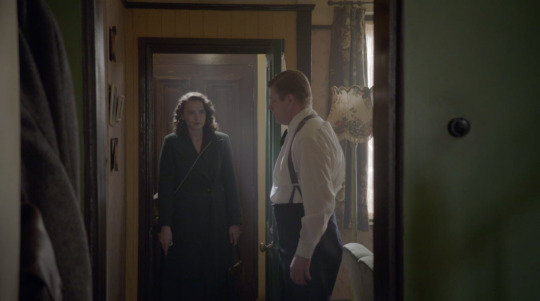
In the middle of these life-changing historical events, characters continue to talk about relationships and their social lives. Lois can’t bring herself to sing one night because she’s heartsick over the realization that her feelings for Harry was a love for a person that never truly existed. Robina and Douglas still have small talk while the latter spoons cubes of sugar into his tea. Stan teases Harry for his two girls back home. Thomasz and Kasia’s interactions are sweet when they get to act like two young adults who aren’t in an occupied country with their lives at risk every minute...then they casually discuss killing a soldier like it’s a fact of life.
Moments like this feel like a kick in the teeth.
On one hand, you could argue that the characters are too blasé about the killings and the risks involved. At one point, Thomasz arrives late to a rendezvous and gives “There was a round-up” as his explanation, almost as if it’s a regular occurrence. On the other hand, wouldn’t it have been? Poland had been occupied for half a year by this point, and maybe Robina was right last episode (to a degree), you do get used to it...or at least, you continue to live alongside it.
All characters undergo a great change in this series, but it’s still startling to see how they react to their circumstances, especially when their reactions are so different from who they were before or how we expected them to be.

Kasia, Harry, and Grzegorz are all placed in perilous situations that ultimately lead to the decision of whether or not to take someone’s life.
Kasia lures an SS officer to a secluded part of town with the expectation that Thomasz will kill him, but when Thomasz has not arrived and the officer starts to go too far, Kasia draws a gun from her purse and kills him. In retaliation for the death of an officer, a new raid is carried out, leading Kasia to come face-to-face with the family of an innocent woman executed for what she did.
The moral quandary in her storyline returns: if killing the enemy results in the death of innocents, do you kill the enemy?

When Harry kills the German sniper, he does it to save his own life, but he also does it to save the lives of the men in his troop. It is one of the few sequences in this show that has the kind of heroics expected of war depictions. But what could in other hands be cathartic violence against non-character antagonists in battle is undercut by Harry’s emotional reaction after the skirmish and the way he freezes at the beginning of the conflict.
He’s not calm-under-fire war hero of fiction, but he’s not exactly a romantic hero, either. Yes, he is the romantic lead of the show, but unlike last episode, he spends his few moments of quiet dealing with his deep-seated familial issues brought out by his powerlessness.

On the run from a death squad, Grzegorz holds a German soldier at gunpoint. The soldier, barely an adult and crying in fear, lowers his jammed weapon. But instead of killing the soldier like Kasia and Harry do, Grzegorz offers his hand. Despite all of the atrocities he has witnessed in the past year: his father’s death, people burned alive in Danzig, narrowly escaping execution, the massacre on the farm, the starvation and sleeping in the woods...and there is still a kind little boy thrown into something much bigger and meaner than he is underneath the exhaustion and self-preservation.
It’s Konrad who kills the soldier, to Grzegorz’s horror.

“I killed one German, just like a German killed your dad.”
“Not that German.”
The landscape of the woods around them changes. Snow dusted ground gives way to moss and mud. A spring fog cloaks their journey. And just as the natural landscape subtly changes, so does their luck.
The two stumble across a troop of British soldiers (wait, where are they?) and quickly join the men. Their relief is short-lived, though, and they are soon back in combat. Konrad is shot through the head.
In order to air with a certain rating, World on Fire has to clean up some of the images of violence. You don’t see blood spurt out of people when they’re shot. The scenes of death are not drawn out.
But the image of Konrad, dead before he hits the ground, blood covering face, with a stunned Grzegorz kneeling over him shocked me.
When Grzegorz grieves, the loss of his family comes out, too, for his father Stefan and father figure Konrad.
In Grzegorz’s final scene, he stumbles through a forest, the British soldiers long gone. Spring is here and beautiful, the snow has melted away, the birds are chirping, and green has returned to the Earth. Grzegorz seems unaware of the world around him, only the journey ahead in the middle of anywhere and nowhere.

Spoiler
The next episode’s promo places him on a beach. Is he transported out of Poland by a ship on the Baltic sea? Or are we supposed to believe Grzegorz and Konrad have spent all winter and spring walking through Poland, Denmark, Germany, the Netherlands, Belgium, and finally into France?
Notes
Konrad calls Grzegorz son...
After a disastrous cup of tea with Douglas, Robina makes sure to pay for the both of their orders before leaving
Tom brings the canary home, a visual connector between Jan and his bird in the pilot and Tom now
When Kasia breaks the news to the Polish family of the executed woman, Thomasz notices a German officer kissing a Polish woman next door, which indicates that not all Poles consider Germans the same way they do (and raises the threat of someone recognizing them later)
Robina casually mentions the newly-appointed Churchill to see Douglas’s reaction
11 notes
·
View notes
Text
French Canadian Cooking 101
So I was discussing French-Canadian food and I came up with the idea of making a little guide for Writeblr and @caz-writes. So for anyone writing or roleplaying in Quebec here’s what the locals often eat!
Side note on other cuisines: Quebec is a very diverse province and Quebecers eat a variety of dishes of foreign origin. Couscous is always popular, so is spaghetti, Chinese-Canadian cuisine resembles American-Chinese food a lot, with a big emphasis on starch.
I’ll put the rest under a cut because this will probably a long-ass post.
Poutine

Everyone knows this one, the queen of fast food. (Poutine is feminine in french) at its base, poutine is fries (preferably “brown and greasy” rather than light and crispy) with gravy and cheese curds.
However, poutine doesn’t stop there, any poutine restaurant worth its salt will offer dozens of topping options. such as various meats, sauces (including spaghetti sauce) The Diallo restaurant chain for a time advertised hundreds of possible combinations.
Paté Chinois
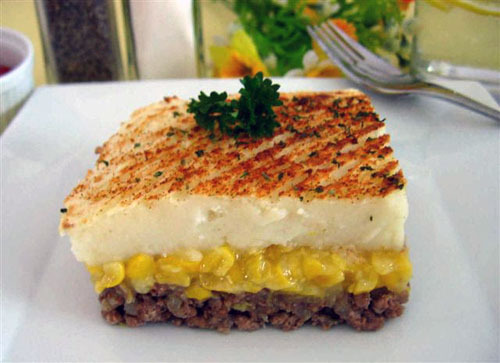
Despite the name, it’s not a paté in the traditional sense. Also, despite its name translates to ‘Chinese paté’ is has nothing to do with Chinese cuisine. What it is, is a layer of mashed potatoes over a layer of creamed corn itself over ground meat, typically with onions.
It’s a simple hearty dish that’s often eaten with plenty of ketchup and I spent most of my life despising. (My mother’s was inedible...)
Hachis
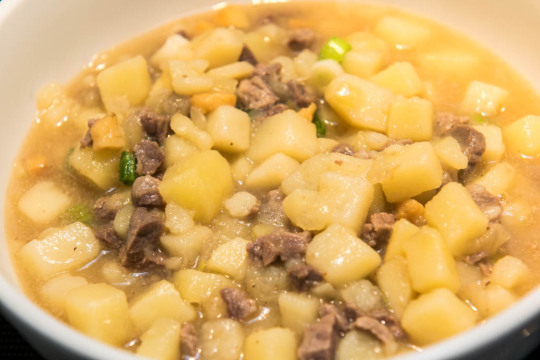
Probably the simplest and laziest dish on the list, Hachis is chopped potatoes and ground beef cooked together, typically with onions and Worchester sauce as seasoning and sometimes with whatever vegetable you have laying around as leftover. Some liquid is generally desirable.
Ragout de pattes et boulette (Leg and meatball stew)

This simple stew is a mix of pork hocks and meatballs along with potatoes, cinnamon and cloves are often used as a seasoning. The base typically includes finely chopped onions and garlic.
Tourtière
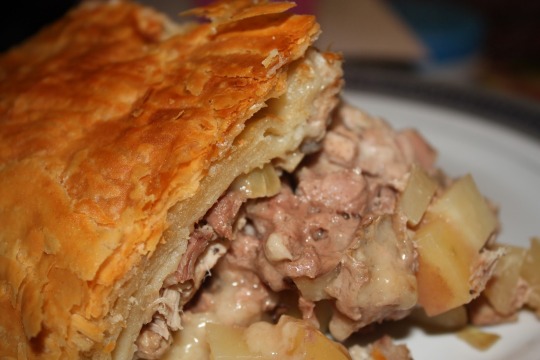
Depending on where you are, tourtière can have very different meanings. In Montreal, it’s typically a simple ground-meat pie, but in some region like my mother’s native Lac-St-Jean, it means cubes of meat with potatoes. Cinnamon, Clove, and nutmeg are often the spice of choice to give a kick to this dish.
Either way, this is the iconic Christmas dish in Quebec.
Cretons

Cretons is a simple paté of finely ground pork, fat, onions, and spices. It’s typically served on toast, often with mustard. It’s a breakfast item and many restaurants will include it as an option with full breakfasts or on its own with toast.
Soupe aux Pois

This very hearty wintery soup is made of split yellow pea and salt pork, along with carrot, onions, and celery. For those who can’t be bothered to make it, it’s easy to find in large cans.
Montreal-Style Smoked Meat

This dish was created by the Jewish population of Montreal and is a Deli favorite (with Schwartz as the uncontested king of smoked meat.) Smoked-meat consist of slow-smoked marinated beef brisket. It’s served with mustard on rye bread.
It’s not really something people make at home, although pre-prepared packages of smoked meat are easy to come by in grocery stores. Typically served with pickles and marinated peppers.
Montreal-style bagel

Montreal-style bagels are thinner, denser, and sweeter than their New York counterpart and are always cooked in wood-fired ovens. The two predominant varieties are poppy seed and white sesame seed.
Orielle de Crisse (Pork Rinds)

A traditional food, pork rinds are known as Orielle de Crisse (Lard ears). Not much else to say there.
Full Breakfast

Many restaurants in Quebec serves full breakfast, which here typically means; your choice of two eggs, toast, baked beans, sausage, ham, bacon, fried potatoes, baked beans, and fresh fruits. This also typically come with a choice of jam, peanut butter or cretons for the toast.
Fêves au Lard (Baked Beans)
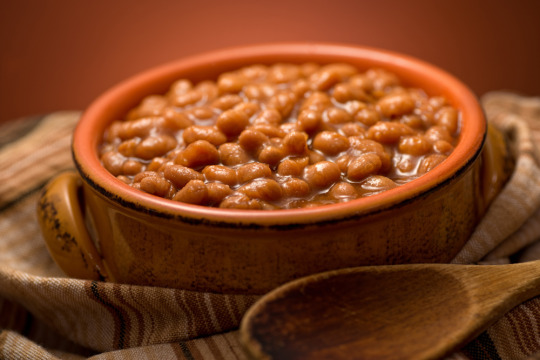
Baked beans are a traditional breakfast item and come in several varieties; old fashioned, in tomato sauce, with maple, or molasses. Most people buy theirs out of a can, ready to eat.
Cabane a Sucre (Sugar Shack)

Okay, so it’s not a dish, but an important and (admittedly odd) element of Quebec food culture. La Cabane a Sucre is a restaurant located among maple forests where people come to get maple candies and eat.
Cabane a sucre typically have a flat price for all you can eat breakfast items such as egg, pancakes, hash browns, toasts and etc. Obviously maple syrup is plentiful.
It’s common for schools and community centers to organize trips there. Because they are remote they tend to have other attractions to keep quests such as discotheques, winter games, sketch artists and the like.
This is also where you can get the following treat;
Tire a la Neige (Maple Taffy)

Okay, so this is probably the most aggressively Canadian thing ever. Maple taffy is made by taking hot maple syrup and pouting it in thin strips on clean snow and letting it crystalize. That’s it!
Pet de Soeur (Nun’s fart...)

Okay, so ignoring the bizarre name, Pet de Soeur or politely known in English as nun's pastries are rolls of pastry dough with cinnamon or molasses in between the various layers, which is sliced into disks and then baked.
Queue de Castor (Beavertails)
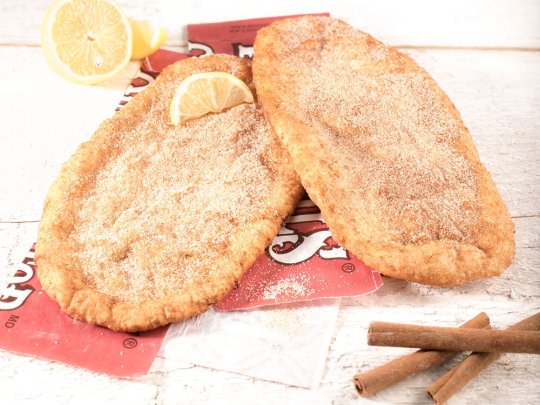
No this has nothing to do with actual beavertails, no rodents were harmed in the making of this iconic carnival dish. Beavertails are at their core a sweet fried dough.
Where they shine is the many, many different toppings you can add to them; from spreads, spices, fresh fruits, it’s hard not to find one that’ll do you good.
Bûche de Noël

This cake is a staple at Christmas celebration and is easily bought in stores around that time of the year.
Tarte au Sucre

This traditional Quebec pie is about the simplest you can get; a firm mixture of flour, butter, salt, vanilla, cream, and brown sugar or maple syrup.
Sucre a la Crème

Can’t be bothered to make a pie? You can basically make this little confectionary. It’s sugar, cream, maple syrup, and vanilla mixture that’s boiled and then set to cool in square molds.
Pouding Chômeur (Poor Man’s Pudding)

Not the custardy type pudding, is a little airy sweet bread typically served covered in caramel sauce.
Ketchup Chip

It’s a stereotype at this point that Canadians love ketchup and... we put them on chips so we can’t exactly argue against it... This one is a bit more Canadian than Quebecer but still very popular alongside the ‘normal’ flavors.
Another popular unusual flavor is dill pickle chips, generally Lay’s.
Clamato and Ceasar
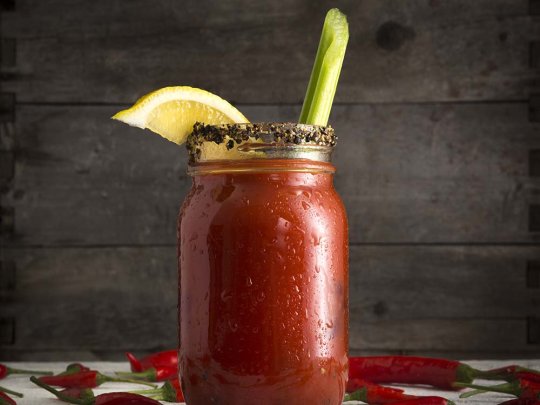
I don’t think anyone but Canadians would think to mix spices, clam juice and tomato juice, bottle it and sell it, but here we are. Clamato is a local drink and quite iconic.
the Ceasar is a cocktail of clamato and vodka, typically with a rind of celery salt, a few dashes of Worcester sauce, tabasco and garnished with a celery stalk and lemon wedge.
That’s about it, folks! I’ve probably left a few things out and might make some latter addendum but for now this is my little 101 into French-Canadian food.
63 notes
·
View notes
Text
Raise Your Beer Mug to the World or How to Say
The Moguls did it. So did the Vikings. “A mouth of a perfectly happy man is filled with beer.” After coining that phrase, you don’t think this anonymous Egyptian from 2200 BC kept it to himself. I can see him raise his drinking vessel to his Nile-side neighbors while repeating the words.
Every country in the world has some sort of traditional drinking toast, often dozens. Usually one or two words, common toasts are not in the same league with toasts to the bride (which can drone on for hours), or to the retiree who’s been with us for 30 years but would rather get to his food while it’s hot. All of these really should be briefer, especially if a meal is being served. The everyday, no black tie, corner pub toasts exist in every culture and the vast majority simply mean ‘I wish you good health’. Not surprisingly it is the English who have strayed from the norm. ‘Cheers’, ‘Down the Hatch’, ‘Bottoms up’ and many more. I always assumed the latter referred to the bottom of the glass, however the Hawaiians have taken this literally. ‘Okole Maluna’ means ‘buttocks up’. I am including a list of multi-national toasts to impress your friends and use as a sign of respect when in the company of people from different cultures.
Here’s a bit of etiquette to go with your cosmopolitan language skills. It is customary to toast the first round, and let the host go first. There is some controversy over the clinking of glasses. It is said that the tradition started as a sly way to test the authenticity of the host’s crystal. Whether the Vikings clinked wooden goblets or not, it is considered more civilized to ‘touch glasses’ rather than bash together in a resounding crash. And while you’re about it, serve on the left and remove from the right!
Toasts From Many Lands
This is just a sampling of simple drinking toasts from around the world. Some are impossible to find in language dictionaries as they are colloquial phrases, slang or in dialect. I apologize in advance for spelling mistakes: I’m no linguist. Meanings have been included when I could find them. Fill in the blanks if you can. Some are just a general ‘cheers’. If you were making a bet on possible translation, you wouldn’t lose money by suggesting that every one of these toasts is wishing the recipient continued health and general well being. My spell check is about to go wild!
za vashe zdorovye (Russian)
slainte duine a ol (Irish) to your health
genatzt (Armenian)
a sua saude (Portuguese) good health
a votre sante (French) to your health
banzai (long life) (Japanese)or
kanpai (dry glass!) (Japanese)
bud mo (Ukranian)
cin cin (chin chin) (cheers) (Italian) or
alla salute (in good health) (Italian)
proost (Dutch) cheers
vivat (Polish) revival, survival
tervist (Estonian) general greeting
skal (Danish) cheers
here’s looking at you (kid, optional) (American/Bogart)
kia ora (Maori) all purpose greeting
egeszsegedre (Hungarian) to your health
Iechyd da (Welsh) good health
I sveikas (Lithuanian) your health
kippis (Finnish) cheers
le’chaim (Jewish) to life
na zdravi (Czech) to your health
noroc (Romanian)
prosit (German) here’s to you (and your health of course)
wen lie (Chinese)
salud (Spanish)
bahkt tu kel (Romany/Gypsy) good luck and health be on you
Here it is folks – oogy wawa (Zulu)
(wawa means ‘fell’, oogy wasn’t listed, any ideas?)
We should all feel well cheered and healthy after all that!
0 notes
Text
Hanukkah Begins
Happy Hanukkah, ProStart! From Nov. 28th to Dec. 6th, people all over the world are celebrating this Jewish holiday also known as “the festival of the lights.” Each night of the eight days of Hanukkah, families light one candle on the menorah just after dark to commemorate the miracle of light. People may celebrate the holiday by playing games, singing songs, giving gifts, or cooking traditional Jewish dishes. A few of our ProStart classrooms tried out some festive recipes this year to celebrate Hanukkah, keep reading to check them out!

Old Colony Culinary’s Challah Bread
The Sophomores at Old Colony Culinary took on the traditional Jewish recipe for braided Challah bread. Challah is an egg-based bread, similar to brioche but doesn’t have any butter or milk. It is a flavorful and moist bread with a distinct brown crust due to the egg wash before baking. It’s great to use for a sandwich, or even French toast! This can especially be enjoyed on the Friday night of Hanukkah in celebration of Shabbat.

Pacific Grove High School’s Matzoh Toffee
While toffee isn’t a traditional Jewish dish, Matzoh bread is a staple in Jewish culture, especially around the holiday of Passover. The bread represents the hardships of freedom for the Jewish people. The ProStart program at Pacific Grove High School took a spin on this tradition, and made Toffee! It’s loaded with nuts and chocolate, giving it that perfect CRUNCH!

Potato Latkes
Pacific Grove didn’t stop there! The ProStart classes prepared these Glorious Golden Latkes using the New York Times recipe. Before these pancakes were made from potatoes, Latkes were originally made with dairy products, like ricotta, dating back to the 14th century Middle Ages. They made the switch to potatoes around the 1800s, and are still used to celebrate Hanukkah in homes all over the world.
What are your favorite Hanukkah recipes? We know we missed a few! We’d love to see what you’re cooking up this holiday season with the hashtag #MadeInProStart.
0 notes